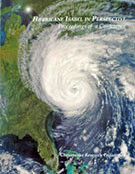Societal learning moments: The importance of timely, synthetic science communication
Bill Dennison ·The 2011 floods in Queensland provide a societal learning moment. The intense media attention and the personal experiences that touched so many people have made a broad swath of society receptive to learning more about flooding and flood impacts. The key from the science communication perspective is to generate timely and synthetic products that are targeted to a broad audience. Since most people are already interested after such an event, it is the role of the science communication to transition people from interested to informed.

A previous example of a societal learning moment was regarding the storm surge associated with Hurricane Isabel in Chesapeake Bay that occurred in 2003. A science newsletter was produced within weeks of the event, describing the processes of sea level rise and land subsidence that made low lying areas more vulnerable to storm surge. A seminar series was initiated, a conference organized "Hurricane Isabel in Perspective" and a book published as a proceedings of the conference by the Chesapeake Research Consortium. Maryland Sea Grant also made public signage, which was placed at strategic locations around the Bay.

Hurricane Isabel historical marker (Credit: Christopher Busta-Peck)
For the 2011 floods in Southeast Queensland, the first step in science synthesis and communication is being produced by the Healthy Waterways Partnership. A science newsletter was produced, focusing on the magnitude of the flood and the extent of the flood plume, and providing an overview of the flood impacts. This newsletter will be followed by other newsletters describing the a) catchment processes, impacts and lessons learned about how land use influences erosion and runoff, and b) flood impacts to Moreton Bay.
One of key aspects that science needs to communicate is the climatic setting of Southeast Queensland, in which drought, punctuated by intense rainfall is the norm. The human footprint needs to adapt to this reality. Brisbane has begun to cope with drought by building large storage reservoirs, water recycling capacity, desalinization plants, and instilling water sensitive design and behavior (e.g., rainwater tanks in houses, gray water use for gardening, water saving fixtures). This shift in emphasis has come about as a result of the prolonged drought of the 1990s. Just as this shift has taken place for the drought portion of the cycle, a shift will need to also occur for the flood portion of the cycle.
The city of Brisbane, and more widely, the region of Southeast Queensland extending from the Sunshine Coast to the north and the Gold Coast to the south has embraced the Brisbane River and the other waterways of the region. Fast catamaran ferries, bikeways along the riverbank, public riverside parks, and various celebrations involving the rivers have been developed over the past couple of decades. Brisbane calls itself the "River City", and hosts the International Riversymposium, has the International Water Centre, International Riverfoundation, and International Water Forum.
The juxtaposition of a vibrant city embracing the river and the waterways with a climatic setting that guarantees occasional large scale flooding will need to be reconciled. The Queenslander house construction principles in which houses are perched on stilts or stumps, above flood levels will need to be embraced. New technologies like floating buildings that can rise with inundation, flood proof infrastructure that can be inundated and not destroyed, can also help. Ultimately, however, part of the reconciliation will have to be NOT placing critical infrastructure in flood prone areas, including power generation and distribution facilities, water treatment and sewage treatment facilities, and food distribution centers. Unfortunately for Brisbane, these facilities are almost all in flood prone areas, and the expensive process of flood-proofing them or relocating them will need to be considered.
Since these decisions about critical life support capacity involve huge costs, they are of necessity highly political issues. What the science communication can do in this context is to insure that the ongoing societal debate will be an informed debate. The science communication will need to dispel urban myths and establish the evidence-based conceptual frameworks that can give the political debate a solid foundation. In this way, science communication used in a societal learning moment can have a lasting impact on the future of the region.
About the author
Bill Dennison

Dr. Bill Dennison is a Professor of Marine Science and Vice President for Science Application at the University of Maryland Center for Environmental Science.



